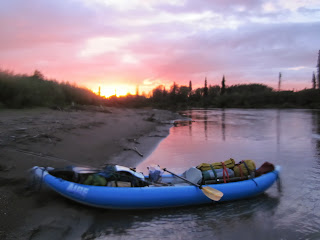At 48 I know a bit more about the nature of the Yukon river, and would probably pick somewhere else for a dream trip.
One possible project is to land in the Aniakchak crater, run the class IV Aniakchak down to where you can carry a few miles over to the Meshik River, and then float fishily down to Bristol Bay. Of course, then you have to somehow schlep a blowup boat several miles up the tidal flats to Port Heiden, where there's an airport, but nobody willing (apparently) to fly turistas around. Expense and lack of services has put that plan on hold until I have some serious sabbatical time again.
Another idea, to go 300 or so miles down the Noatak (pictured above) has arisen, but in the end, that project seems likely to suffer from a fundamental problem: long stretches of fishing-challenged paddling (and probably against some serious wind and weather). I'm sure the Noatak's fishing kicks the ass of just about any float I could do here in California. But is it in the same league as the salmon-swarmed, biologically rich rivers of the Bristol Bay and Kuskokwim drainages further South?
The Aniak River (in the Kuskokwim Kountry) presents itself as a great compromise for balancing the wild & remote with the fishy & fun. Second-hand sources have commented that, "90% of the time I was floating down the Aniak I was scared out of my wits; but the other 10% I was having the best fishing of my life." When I heard this a few years ago, I thought: "There."
So, in 2013 I showed up in Aniak village with my maps and GPS and yak and all my homework done, raring to get in there are start climbing over logjams (for which the river is famous). I quickly discerned that the pilot guy in Aniak is a little bit crazy, but, worse, I soon learned that he also a little bit cautious: because conditions were worse than usual on the main stem Aniak, he could only in good conscience drop me on the Salmon River, a relatively tame tributary of the Aniak. Arguments ensued. But rather than bag the whole trip, I sucked it up and started my float on the Salmon. It turned out to be no stick in the eye, as my first-night happiness attested:
However, it was still frustrating. After a terrific trip full of cohos and rainbows and pike and sheefish, I beached my yak at Aniak village and radioed for my pilot to pick me up in the pickup. What does he say as soon as he sees my yak fully inflated and loaded on the beach? "You know, I bet you could have got through the main stem in that thing."
Fast-forward past a 2014 plan cancelled due to buying, of all things, a goddamned house, and we find your correspondent six days away from the same routine: packing up that blue yak and landing in Aniak village raring for a rare and wondrous float trip. This time I have been mildly concerned about a knee tweak in particular and my overall fitness for paddling in general, but as we get to the final prep stages, I feel READY. Crazy Pilot informs me that the river has been as clear and friendly this year as ever.
So it's on! Starting next Sunday afternoon, I'll land on Aniak Lake and get ready for twelve nights on the river. At last, I'll get to see the mouths of Atsusovluk Creek and the Kipchuk River where they empty fishily into the upper Aniak. I'll get to climb over some logs! Eventually, I'll get to familiar scenes at the confluence with the Salmon, and I'll fish the sublimely woggy pool there before moving on to more GPS-marked sweetspots: "Cohomax," for a coho-a-cast slough; "Mousey" for a small tributary with a great cutbank for fishing the mouse; "Slam" where I got all main species (bow, grayling, char, coho and chum) in one riffle, and "Slay," which I don't remember exactly, but sounds promising. The Doestock mouth will have pike, and may produce another sheefish or two for me. I have high and fairly realistic hopes of a seven-species fish-o-rama.
Given my advancing age and decrepitude, will this trip be the climax of my wilderness floating career? That's possible. Over the past ten years, I've found that my fitness goes down for spells (plantar fascitis, gout attacks, full-time jobs intruding) and then goes up again (biking fitness, Baja trips, younger women contributing). Hopefully on one of the ups, I'll get my sorry old ass to the Aniakchak crater, and maybe even haul a Feathercraft to the headwaters of the Noatak. I can dream.
But what's way more exciting than any dream, is execution. Six days and counting down.






